Long Bien Bridge in Hanoi, Vietnam, stands as an enduring emblem of the city’s resilience, history, and architectural grandeur. From its colonial-era construction to its pivotal role during the Vietnam War, the bridge remains a testament to the spirit and determination of the Vietnamese people. For over 120 years, it has captured the imagination of artists, writers, and filmmakers, becoming an iconic cultural landmark. This article delves into the bridge’s multifaceted significance its history, architectural marvels, resilience in the face of war, cultural impact, tourism experiences, and practical details on how to visit.
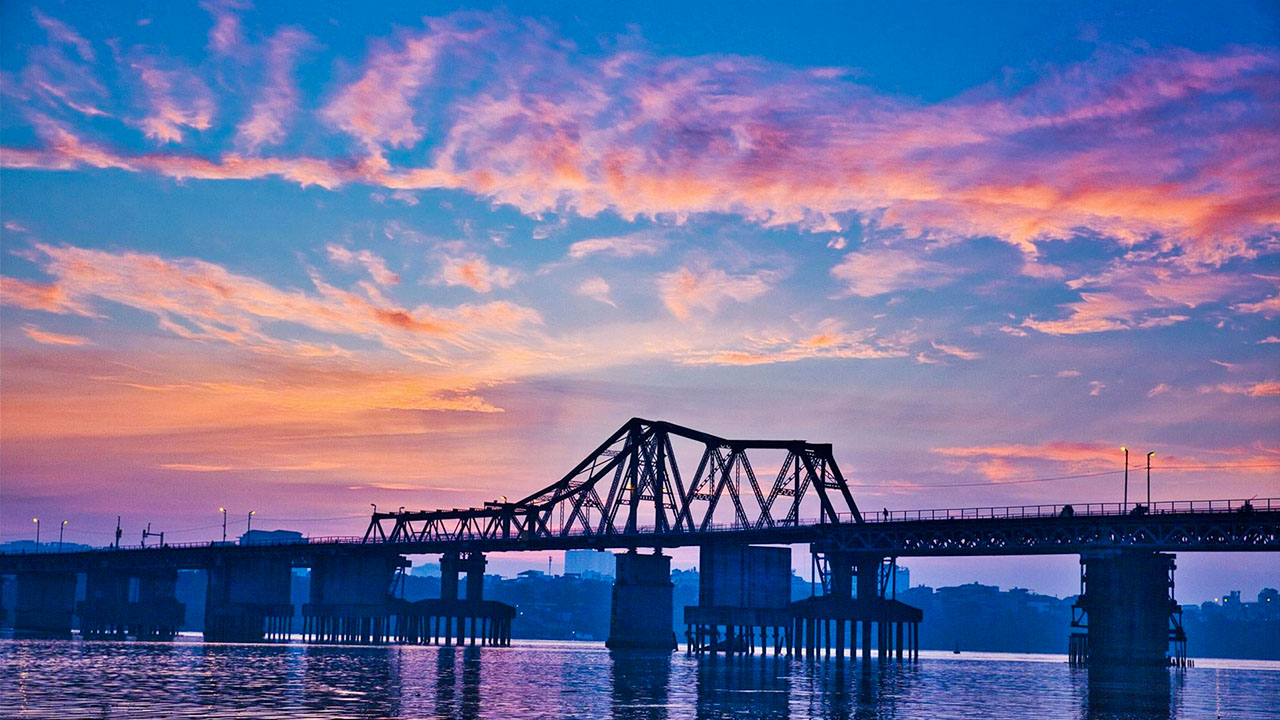
History and Construction
French Colonial Era: 1899-1902
The history of Long Bien Bridge dates back to the French colonial era, specifically between 1899 and 1902. The colonial administration sought to establish a stronghold in the region, and an architectural marvel like Long Bien Bridge served that purpose well. At that time, French engineers and Vietnamese laborers worked symbiotically on this pioneering project. The venture was not merely a construction effort but a symbol of Western technological prowess juxtaposed against the rich cultural backdrop of Vietnam.
French architects from the firm Daydé & Pillé designed the bridge. Yet, it was the Vietnamese workers who brought it to life, using local materials like wood from the provinces of Phu Tho, Yen Bai, and Thanh Hoa, cement from Hai Phong, and lime from Hue. It’s fascinating to see how local resources contributed to an engineering marvel that many would associate with Western technology. The project took 45 months to complete, even though the initial estimate was 60 months. This collaborative effort between foreign design and local execution resulted in one of the most technologically advanced bridges of its time, living proof of a complex and multifaceted colonial history.
The “Paul Doumer Bridge”
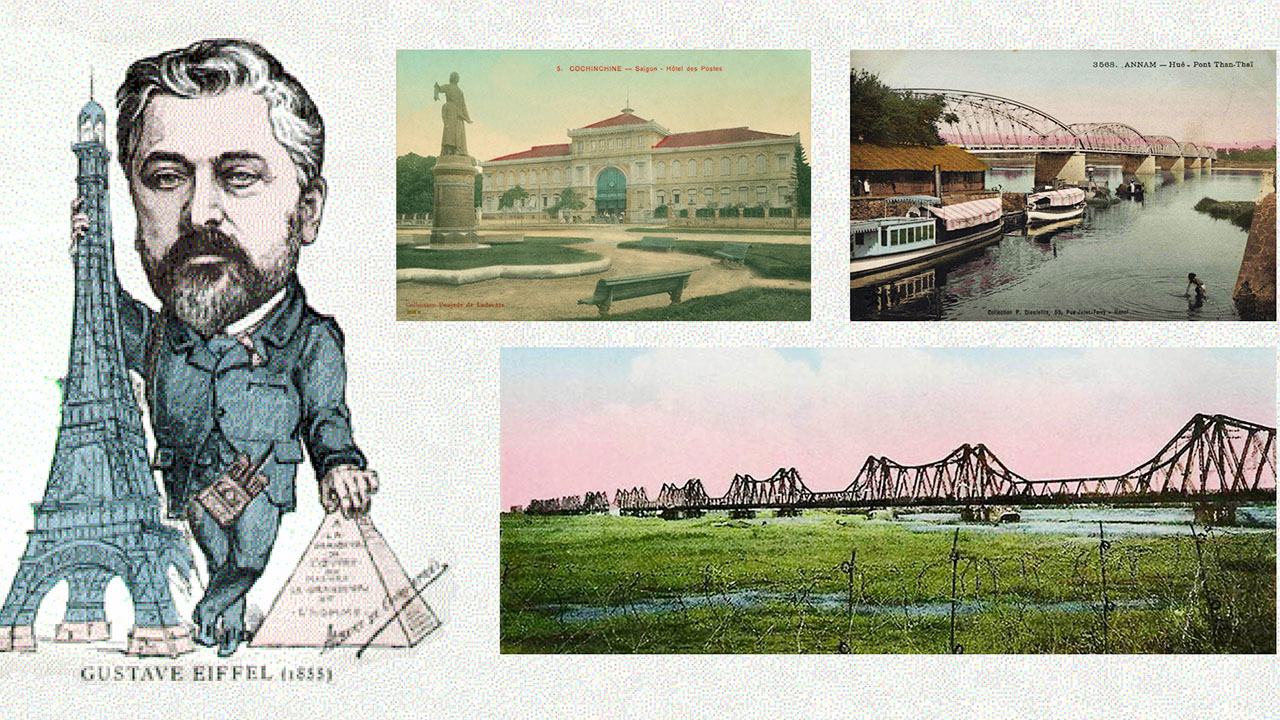
Named after Paul Doumer, the Governor-General of French Indochina and later the French President, the bridge was initially known as the “Paul Doumer Bridge.” This name itself holds layers of historical significance. Paul Doumer was a prominent figure, and naming the bridge after him underscored the French colonial government’s intent to leave a lasting impact on Vietnam. However, for the local people, the renaming of this structure to “Long Bien Bridge” post-independence marks a reclaiming of their heritage and history.
Construction Materials and Workers
What sets Long Bien Bridge apart from other monumental structures of its time is its use of indigenous materials and local labor. Unlike other colonial projects that might have entirely relied on imported materials and expertise, this bridge stands as a testament to the local craftsmanship and readily available resources. Workers from various provinces brought wood, cement, and lime each element narrates a story of regional participation and unity. This synthesis of local and imported resources not only reduced costs but also embedded the bridge firmly in the cultural and geographical landscape of Vietnam.
The Inauguration and Significance
The bridge was officially inaugurated on February 2, 1902, and the first train crossed it on February 28, 1902. The ceremony was attended by dignitaries such as French Governor-General Paul Doumer, his successor Paul Beau, and the young King Thanh Thai. The atmosphere of the day has often been described as a mixture of awe and pride, as the structure was not just a bridge but a monumental leap in Vietnam’s connectivity. The bridge’s strategic role became evident as it connected Hanoi to the port city of Haiphong, facilitating trade and strengthening French influence in the region.
The Second Longest Bridge in the World
Upon its completion, the Long Bien Bridge was the second longest bridge in the world, a title that only added to its global significance. Stretching 2.72 kilometers with 19 spans resting on massive stone piers, the bridge combined aesthetic brilliance with functional utility. The only bridge longer than it at the time was the Brooklyn Bridge in the United States. Such a comparison instantly elevates Long Bien Bridge to an international league of engineering marvels, proving that it was not just a local achievement but a global one.
The Bridge’s Architectural Style
Often referred to as a “horizontal Eiffel Tower,” the Long Bien Bridge features a unique cantilever design that was both practical and visually stunning. The structure’s 19 spans and 20 columns exhibit a blend of elegance and robustness, echoing the design principles of Gustave Eiffel, though not directly attributed to him. The architectural style is a noteworthy blend of French influences and Vietnamese practicality, offering a picture-perfect view that many find inspiring. This complex design has since stood the test of time, becoming a beloved icon in the Hanoi skyline.
Comparison Table: Construction Materials and Workers
| Material | Source | Contributions |
|---|---|---|
| Wood | Phu Tho, Yen Bai, Thanh Hoa | Structural elements |
| Cement | Hai Phong | Binding materials |
| Lime | Hue | Mortar and finishing |
| Design | Daydé & Pillé, Paris | Architectural design and blueprints |
| Skilled Labor | Vietnamese Workers | Construction and assembly |
The Vietnam War and Beyond
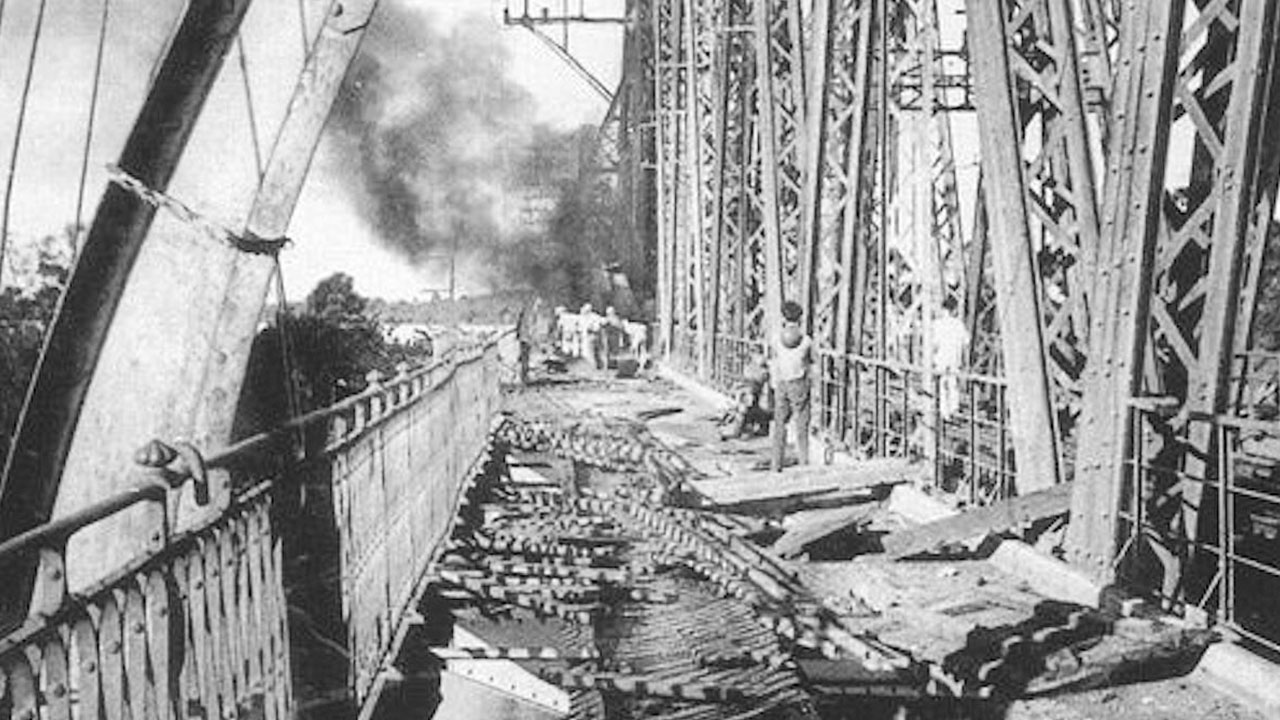
Bombing and Damage
Long Bien Bridge’s strategic importance became even more apparent during the Vietnam War. Its location made it a key military objective and a prime target for American bombing raids. The relentless attacks aimed to disrupt the crucial supply routes between Hanoi and the port city of Haiphong. In 1967, one of the major bombings by 20 USAF F-105 fighter-bombers severely damaged the center span. The calamity didn’t end there; another series of bombings during Operation Linebacker in 1972 further devastated the structure, destroying seven spans and four support columns. The devastation, however, couldn’t shatter the indomitable spirit of the people who depended on it.
The Bridge’s Resilience
What truly sets the Long Bien Bridge apart is its resilience. Despite considerable damage, the bridge was an enduring symbol of defiance. The Vietnamese undertook extensive repairs immediately after each bombing, tirelessly restoring and fortifying the bridge. Temporary pontoon bridges were erected to maintain this vital link, showcasing remarkable ingenuity and determination. The bridge thus became an epicenter of resilient spirit and pragmatic engineering. For the Vietnamese, repairing the bridge was not just an act of necessity but a profound statement of their will to stand against adversity.
Post-War Reconstruction
In the aftermath of the war, extensive reconstruction efforts began. Much of the material required for rebuilding came from the Soviet Union, which provided steel to restore the damaged sections. By March 1973, trains once again traversed the route from Hanoi to Gia Lam junction, signaling a return to normalcy. However, these reconstructions paved the way for a blend of old and new, with only half of the bridge retaining its original appearance. This makes the bridge an interesting case study in patchwork restoration, combining old-world design with new-world materials.
Modernization and New Bridges
Over the decades, modern Hanoi saw the construction of several new bridges that alleviated some of the pressure from Long Bien Bridge. The Chuong Duong Bridge, Thang Long Bridge, Vinh Tuy Bridge, and Nhat Tan Bridge each brought their architectural and engineering innovations to the landscape. However, Long Bien Bridge remains steadfast, serving a mix of trains, mopeds, bicycles, and pedestrians. Although plans have been floated to modernize or relocate it into Hanoi’s public transportation system, the bridge’s historical and cultural significance often outweighs these considerations, securing its place in the heart of Hanoi’s heritage.
Current Use and Traffic
Despite its aged and somewhat dilapidated structure, the Long Bien Bridge continues to serve as a major transportation link. It caters to everything from trains to mopeds, bicycles to pedestrians, each contributing to the daily hum of life on the bridge. In recent years, a makeshift community has sprung up beneath the bridge, with poor families living in boats or shanties. These families come from rural areas, seeking livelihood in the shadow of this towering symbol. For tourists, this adds another layer of authenticity and history to an already captivating structure.
List: Key Milestones in the Vietnam War and Beyond
- 1967: Major bombing by 20 USAF F-105 fighter-bombers destroys the center span.
- 1972: Operation Linebacker bombings devastate additional spans and support columns.
- 1973: Reconstruction with steel from the Soviet Union; Hanoi to Gia Lam junction reopens.
- Late 20th Century: New bridges (Chuong Duong, Thang Long, Vinh Tuy, Nhat Tan) alleviate some traffic.
- Present Day: Continuous use by trains, mopeds, bicycles, and pedestrians.
Cultural and Symbolic Significance
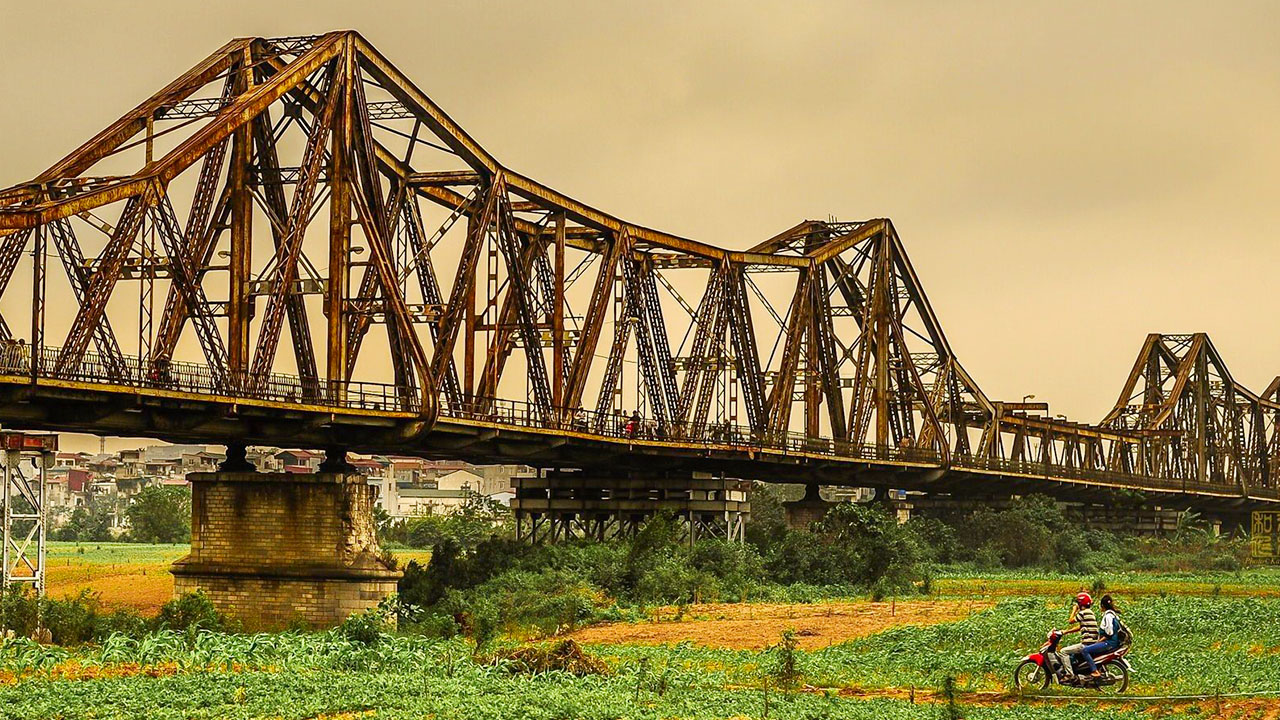
A Historical Landmark
Long Bien Bridge is more than just an old steel structure; it’s a historical landmark that has witnessed countless events shaping Hanoi and Vietnam. Its narrative encapsulates colonial rule, wars for independence, and modern development, making it a vivid timeline of Vietnam’s history. The bridge has seen various phases of transformation, but its essence remains unchanged a sturdy reminder of times gone by and battles fought. From French engineers walking its planks to Vietnamese scouts planning guerilla maneuvers, the bridge stands as an observer to it all.
The Symbol of Hanoi’s Resilience
Throughout its history, Long Bien Bridge has symbolized the resilience of Hanoi and its people. It is not just the skeletal framework of steel and stone but the spirit of defiance and perseverance embodied in its structure. The bridge was repeatedly bombed during the Vietnam War, and each time it was painstakingly repaired. This cycle of destruction and reconstruction became a metaphor for Hanoi’s resilience, much like a phoenix rising from the ashes. The communal effort to keep the bridge standing translated into broader national pride and unity.
A Source of Artistic Inspiration
Beyond its structural and historical importance, Long Bien Bridge has been a wellspring of artistic inspiration. Over the years, its iconic silhouette and evocative aura have inspired countless artists, photographers, and filmmakers. The “horizontal Eiffel Tower” stands as a muse for many, appearing in various paintings, photos, and films that capture its allure. Its blend of French design and Vietnamese cultural elements offers a juxtaposition that’s visually and emotionally compelling, making it a favorite subject for artistic expression.
The Bridge in Literature and Film
The symbolic nature of Long Bien Bridge extends into literature and film, where it often serves as a powerful metaphor. Numerous Vietnamese novels and poems incorporate the bridge as a setting or symbol, weaving it into the very fabric of narrative storytelling. This intricate involvement in literature accentuates its timeless beauty and multifaceted significance. Similarly, Vietnamese filmmakers have often used the bridge as a visual shorthand for Hanoi’s enduring spirit and intricate history, bringing its story to life for newer generations.
The Bridge in Local Culture
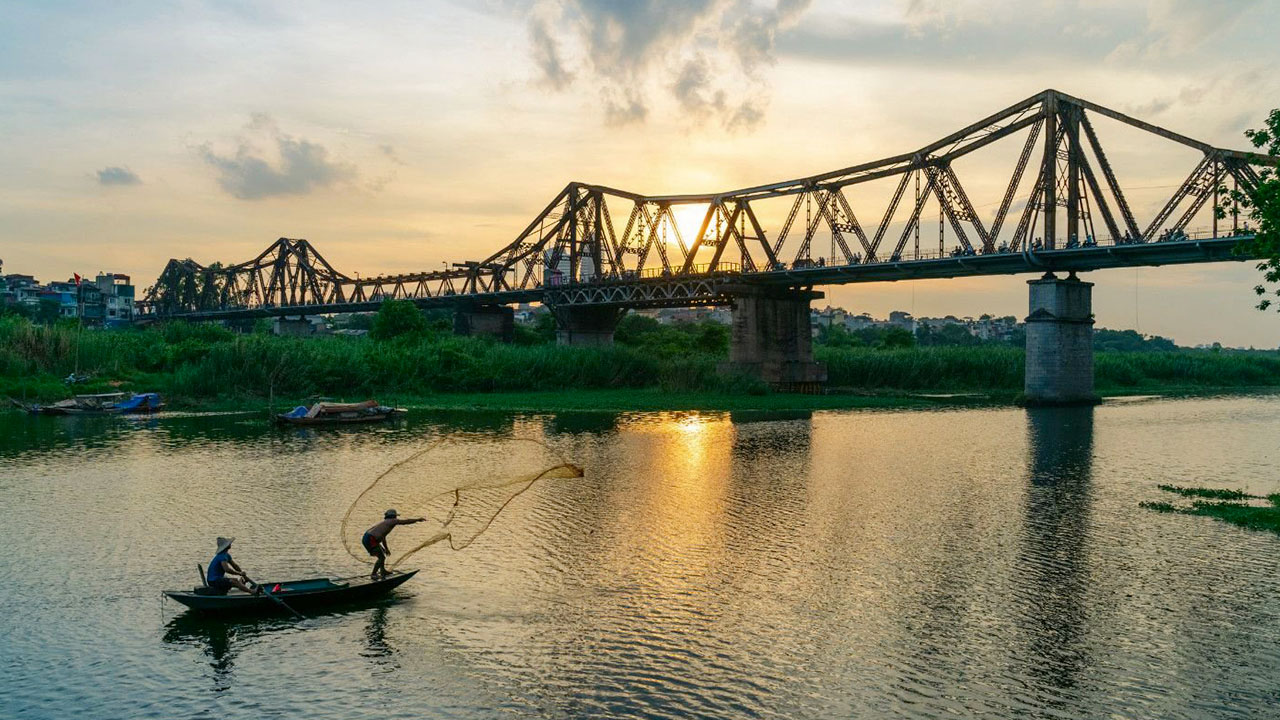
Locally, the bridge holds an almost sacred spot in Hanoi’s cultural landscape. From daily commuters to elderly citizens reminiscing about times gone by, the bridge is a ubiquitous part of the city’s cultural identity. Stories and legends surrounding its construction and endurance are passed down through generations. Festivals, community events, and local markets around the bridge further cement its place in the daily lives of Hanoi’s residents. The Long Bien Bridge is not just an architectural marvel; it’s interwoven into the social and cultural tapestry of Hanoi.
Illustrative Examples: The Bridge in Media and Art
- Photography: International and local photographers consistently choose the bridge as a backdrop for capturing authentic and picturesque scenes of Hanoi.
- Literature: Featured prominently in novels like “The Sorrow of War” by Bảo Ninh, symbolizing the turmoil of war and the resilience of the human spirit.
- Film: Used as a significant setting in films such as “The Long Bien Bridge: Pathway Between War and Peace,” encapsulating the dichotomy of conflict and resolution.
Tourism and Experience
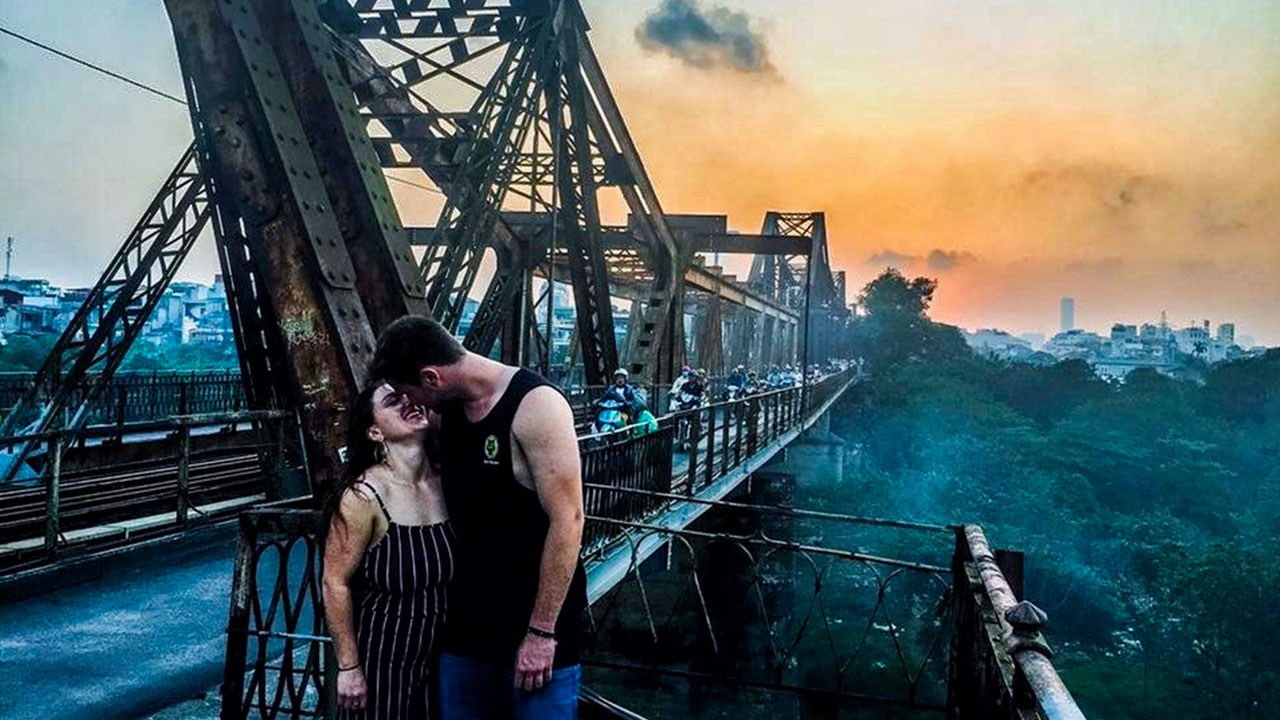
Walking or Biking Across the Bridge
For tourists visiting Hanoi, walking or biking across Long Bien Bridge is a must-experience activity. This journey offers a unique opportunity to escape the chaotic bustle of Hanoi’s streets and enjoy the serene surroundings of the Red River. The bridge’s pedestrian walkway and biking paths allow visitors to take in not just the architectural beauty but also the sweeping panoramic views it offers. Whether it’s the early morning mist or the glow of the setting sun, the experience of traversing the bridge is imbued with a distinct sense of tranquility.
Sunrise and Sunset Views
Long Bien Bridge is particularly renowned for its breathtaking sunrise and sunset views. Early birds and night owls alike congregate on the bridge to witness these natural spectacles, frequently capturing them on camera. The bridge provides an excellent vantage point to observe the harmonious interplay of light and shadow over the Red River, creating moments of pure beauty that many find soul-stirring. These views have become so iconic that entire tours and photography sessions are often centered around capturing the perfect sunrise or sunset on Long Bien Bridge.
The Middle Island of Red River
As you walk or bike across the bridge, it’s worth taking a moment to descend to the middle island of the Red River. This naturally scenic spot offers a peaceful escape from the hustle and bustle, providing visitors with a quiet place to relax and take in the natural beauty. The island, although small, serves as a tranquil haven where one can reflect on the journey or simply bask in the serene atmosphere. Its scenic vistas and the opportunity to observe local flora and fauna make it a hidden gem for nature enthusiasts.
The Cho Dau Moi Long Bien Market
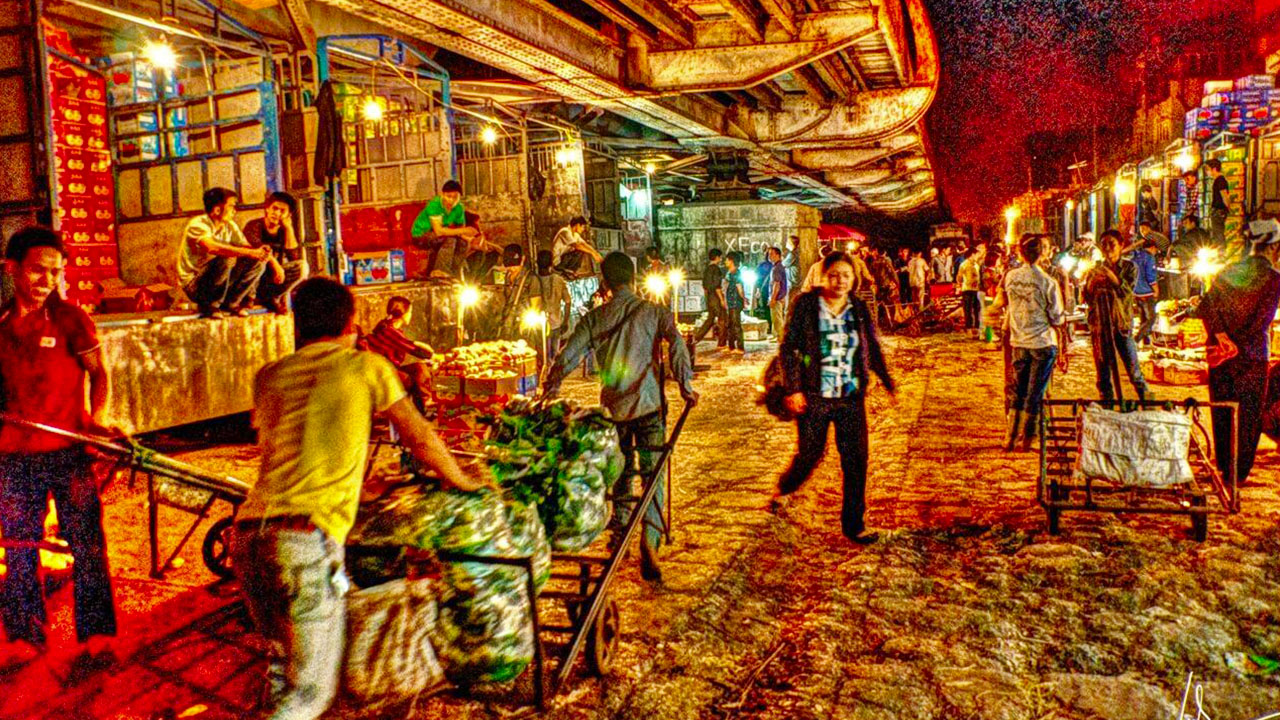
Located near the Long Bien Bridge, the Cho Dau Moi Long Bien Market is a bustling hive of activity and a window into local life. Known as Hanoi’s largest and busiest fruit market, it offers visitors a glimpse of a traditional Vietnamese market in full swing. From the vibrant colors of tropical fruits to the dynamic buzz of traders, the market embodies the daily hustle that characterizes Hanoi. A visit here is akin to stepping into a different world, where you can witness the city’s heartbeat through its commerce.
Photography Opportunities
Photography enthusiasts will find Long Bien Bridge a compelling subject. Its rustic charm and historical aura provide diverse backdrops, ideal for capturing both traditional and modern aesthetics. From the intricacies of its steel framework to the expansive views of the Red River, every angle offers a unique photographic opportunity. Many professional and amateur photographers are drawn to this location, making it a well-known spot for capturing the essence of Hanoi. Whether it’s portrait photography, landscape shots, or simply capturing the hustle and bustle, Long Bien Bridge does not disappoint.
List: Top Photographic Spots Around the Bridge
- Overhead bridge shots: Capture the entire length of the bridge against the backdrop of the Red River.
- Middle Island viewpoints: Offers unique angles of the bridge framed by natural scenery.
- Sunset and sunrise vantage points: Optimal locations for capturing the golden hues of dawn and dusk.
- Under-the-bridge views: Highlighting the architectural marvel from an unconventional, yet striking angle.
- Market scenes: The bustling activity around Cho Dau Moi Long Bien provides excellent opportunities for candid photography.
The Food Street (Cho Am Thuc Ngoc Lam)
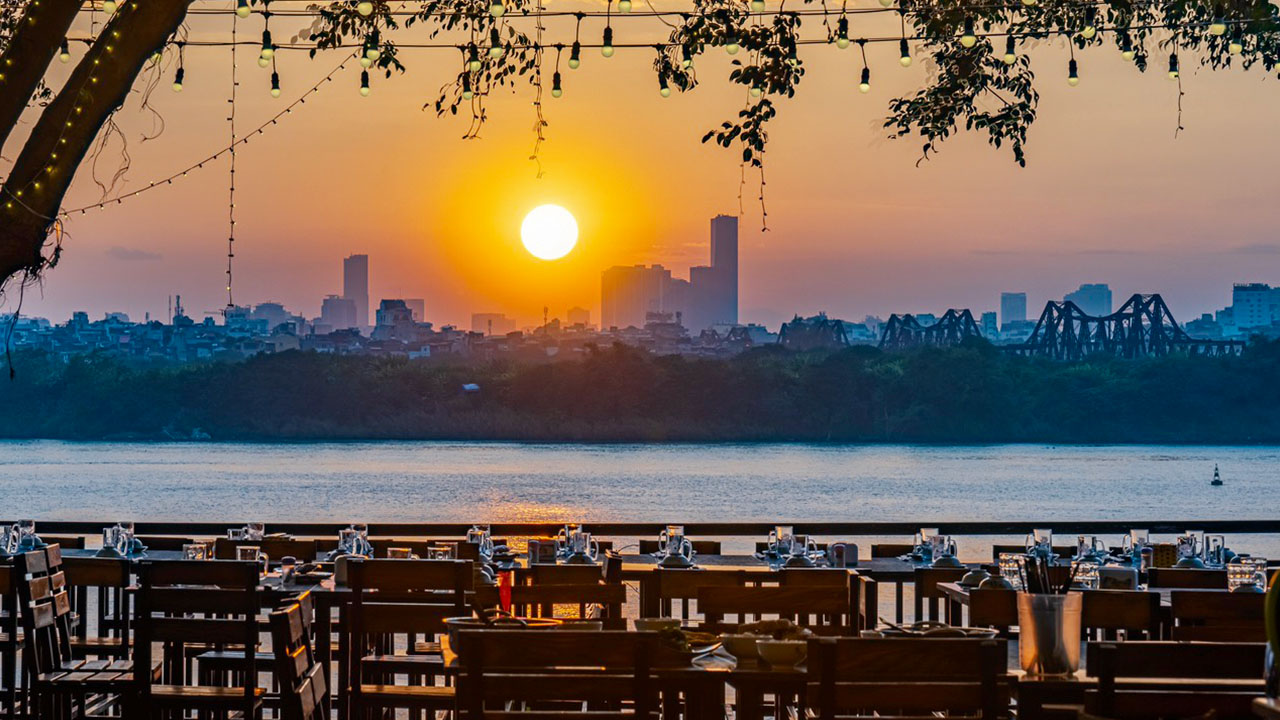
Adjacent to Long Bien Bridge is the Cho Am Thuc Ngoc Lam, a food street famous for its gastronomic delights and proximity to scenic views. This sprawling riverfront food street is popular with locals and offers some of the best seafood in the city. Here, one can find a diverse array of culinary options ranging from traditional Vietnamese dishes to modern fusion cuisines, ensuring a delightful experience for food lovers. Scenic views of Long Bien Bridge and the Red River add a wonderful backdrop to this culinary adventure.
List: Must-Try Food Spots Along Cho Am Thuc Ngoc Lam
- Xoi Ga Gio Trung Co Hong: Known for its delicious sticky rice with chicken, eggs, and pork.
- Che Hue 267 Ngoc Lam: Offers traditional Hue-style desserts.
- Nem Nuong Nha Trang at Hoa Beo: Specializes in grilled pork sausages.
- Bun Cha Hang Manh: Renowned for its flavorful grilled pork and noodle dish.
- Banh Cuon Gia Truyen: Famous for its rice rolls stuffed with ground pork and mushrooms.
Getting There
Walking from the Old Quarter
For those staying in Hanoi’s iconic Old Quarter, the Long Bien Bridge is conveniently within walking distance. The roughly 1-kilometer stroll will take you through some of Hanoi’s most vibrant neighborhoods, allowing you to experience the local atmosphere along the way. The walk itself is straightforward, taking about 15-20 minutes and providing an opportunity to observe various architectural styles, bustling street markets, and local cafes. This route is particularly favored by tourists who have a keen interest in experiencing the cultural nuances of the city on foot.
Public Transportation Options
For travelers who prefer not to walk, Hanoi offers a variety of public transportation options to reach Long Bien Bridge. The city’s extensive bus network ensures easy access to the bridge from almost anywhere in Hanoi. Bus routes No. 01, 14, 15, 22, 34, 47, and 55 all make stops near the bridge, allowing for convenient and affordable travel. Whether you’re arriving from the Old Quarter or other parts of the city, public transportation provides a hassle-free way to reach this historic landmark.
Bus Routes to Long Bien Bridge
Exploring Hanoi via its well-connected bus network can be both an economical and efficient way to travel. Below is a list of some bus routes that will take you to Long Bien Bridge:
List: Recommended Bus Routes
- Bus No. 01: Connects Hanoi Railway Station to Gia Lam Bus Station, stopping near Long Bien Bridge.
- Bus No. 14: Travels from Tran Khanh Du Street to Long Bien Transshipment Spot.
- Bus No. 15: Goes from Dong Anh District to the base of the bridge.
- Bus No. 22: Passes through major tourist spots and stops near Long Bien Bridge.
- Bus No. 34: Connects My Dinh Bus Station to Gia Lam, with a stop near the bridge.
- Bus No. 47: Runs from Long Bien Transshipment Spot to the historic sites nearby.
- Bus No. 55: Travels from Nam Thang Long to the points near Long Bien Bridge.
Points of Departure
When planning your trip to Long Bien Bridge, knowing the key points of departure is essential. Whether you’re staying in a hotel near Hoan Kiem Lake or closer to West Lake, the city’s transport system is efficiently planned to facilitate easy movement. Typically, travelers depart from central locations such as Hanoi Old Quarter, Hoan Kiem Lake, and popular tourist spots nearby.
Accessibility for Tourists
Hanoi, like many popular tourist cities, ensures that significant landmarks like Long Bien Bridge are easily accessible. English-speaking services, comprehensive buses, and user-friendly maps contribute to a seamless travel experience for foreign visitors. Many hotels and hostels in the Old Quarter offer guided tours to Long Bien Bridge, providing an insightful journey to this historical structure. For those who prefer independence, renting a bicycle or moped is also a viable option, allowing for a personalized exploration of the city and its landmarks.
In conclusion, accessing Long Bien Bridge is remarkably straightforward, whether you choose to walk, use public transportation, or rent a vehicle. Its central location and the myriad of transportation options make it a must-visit for anyone exploring Hanoi.
List: Accessible Services for Tourists
- Guided tours: Available at most hotels and hostels in the Old Quarter.
- Bicycle Rentals: Various rental shops offer affordable rates.
- Moped Rentals: Convenient for those who wish to explore the city at their own pace.
- Taxi and Cyclo Services: Readily available for a comfortable commute.
- Bus Stops: Clearly marked and well-connected routes for ease of travel.
Long Bien Bridge’s accessibility, historical significance, and the myriad of experiences it offers make it a must-visit for any traveler exploring Hanoi. Continuing our detailed guide, we will further explore the cultural dimensions, local anecdotes, and perhaps uncover some hidden gems around the vicinity.
Conclusion
Long Bien Bridge embodies Hanoi’s robust history, cultural richness, and indomitable spirit. From its colonial origins as the “Paul Doumer Bridge” to its resilient stance through the Vietnam War, it stands as a testament to human endeavor and communal resilience. The bridge’s architectural brilliance, coupled with its role in local culture and artistic inspiration, renders it a pivotal landmark in Hanoi.
Today, Long Bien Bridge serves as a vital transit link, a scenic spot for tourists, and an evocative muse for artists and thinkers. Its metal bones hold stories of the past, narrate the sagas of resistance and restoration, and continue to inspire fortitude in the face of challenges. Visiting Long Bien Bridge offers a rich tapestry of experiences from historical insights and cultural interactions to stunning visuals and serene escapes.
Whether you’re traversing its expanse on foot or via bike, capturing its beauty through the lens, or simply savoring a sunset over the Red River, Long Bien Bridge promises an enriching journey that resonates deeply with Hanoi’s spirit. This timeless symbol is not just a bridge but a passage into the heart of Vietnam, merging the past, present, and future in its enduring embrace.
Key Takeaways:
- Resilient Landmark: Symbolizes Hanoi’s historical resilience and spirit.
- Architectural Marvel: “Horizontal Eiffel Tower” with a unique cantilever design.
- Cultural Hub: Central to local traditions, festivals, and community life.
- Tourist Attraction: Walks, bike rides, markets, and photography spots.
- Artistic Inspiration: A muse for artists, photographers, and filmmakers.
Long Bien Bridge isn’t just a site to visit it’s an experience to live, a story to be a part of, and a piece of history that continues to shape Hanoi’s present and future.
With this, the article offers a comprehensive and in-depth exploration, blending historical context, cultural insights, and practical travel information seamlessly. The Long Bien Bridge reveals its many layers, inviting readers to delve into its storied legacy and vibrant present.


